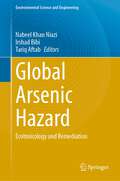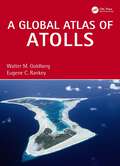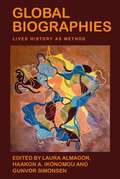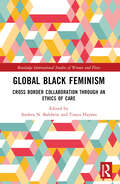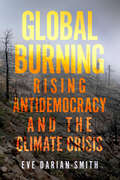- Table View
- List View
Global Aquatic and Atmospheric Environment
by Har D. Kumar Donat-P. HäderDuring the last few decades anthropogenic activities in the industrially advanced countries have outcompeted nature in changing the global environment. This is best illustrated for example by the polluted lakes in Scandinavia and Canada, associated with acid deposition from fossil fuel combustion. One of the major challenges mankind is confronted with in the field of energy consumption is undoubtedly to ensure sustainability - a goal that requires improved management of natural resources and a substantial reduction of the noxious emissions which are dangerous to health and the environment. The threat of global climate change due to pollutant emissions causes se rious concern to many nations, and reaching an international consensus is likely to take some time. Carbon dioxide emissions have slowed only marginally in industrialized countries during the last few years, but have increased significantly in most developing countries due to increases in energy demand and the increasing use of fossil fuels, which remain the most readily available energy sources today. Unfortunately, far from learning lessons from the negative experiences of developed countries, many developing countries are taking the same path to development which has turned out to result in serious environmental consequences.
Global Arctic: An Introduction to the Multifaceted Dynamics of the Arctic
by Matthias Finger Gunnar RekvigThe Arctic has become a global arena. This development can only be comprehensively understood from a transdisciplinary perspective encompassing ecological, cultural, societal, economic, industrial, geopolitical, and security considerations. This book offers thorough explanations of Arctic developments and challenges. Global warming is in large part the driving force behind the transformation of the Arctic by making access possible to the areas previously out of reach for mining and shipping. An all-year ice-free Arctic Ocean, a reality possible as soon as perhaps 2030, creates a new dynamic in the North. The retreating ice edge enables the exploitation of previously inaccessible resources such as hydrocarbon deposits and rare metals, as well as the shortest sea route from Asia to Europe. Consequently, the Northern Sea Route (NSR) promises faster and cheaper shipping. Russia, along side foreign investment, especially from China, is financing the needed infrastructure. A warming Arctic, however, also has negative impacts. The Arctic is home to fragile ecosystems that are already showing signs of deteriorating. The Arctic has seen unprecedented wildfires, which, together with the release of trapped methane from the disappearing permafrost, will, in turn, accelerate global warming. A warmer Arctic Ocean will also negatively impact fisheries. Couple this with other global changes, such as ocean acidification and modified ocean currents, and the global outlook is bleak. Additionally, the security situation in the Arctic is worsening. After the 2014 Ukraine crisis, the West imposed sanctions on the Russian Federation, which have revived the divisions of the Cold War. The reemergence of these postures is threatening the highly successful Barents Cooperation and other initiatives for peace in the circumpolar North. This book offers new insights and presents arguments for how to mitigate the challenges the Arctic is facing today.
Global Arsenic Hazard: Ecotoxicology and Remediation (Environmental Science and Engineering)
by Tariq Aftab Nabeel Khan Niazi Irshad BibiThis book provides a plethora of information about global arsenic (As) contamination and the challenges for environment. Arsenic is a naturally occurring metalloid that is widely distributed in water, soil, air and biota from natural and anthropogenic sources. Arsenic has been found in drinking water in over 100 countries worldwide, which caused a major public health issue including: cardiovascular disorders, diabetes, and cancers of various organs - these are some of the general health effects of As exposure. Exposure of plants to As, even at very low concentrations, can cause many morphological, physiological, and biochemical changes. The recent research on As in the water-soil-plant-human systems indicates that As toxicity to plants varies with As speciation in plants, type of plant species and with other soil factors controlling As accumulation in plants. In recent years, the development of efficient green chemistry methods for detoxification of trace metal poisoning has become a major focus of researchers. It has been investigated in order to find an eco-friendly and recyclable technique for the removal of As contamination from the natural resources.Understanding the significance of As hazard and roles of sustainable or eco-friendly approaches in its mitigation, we intend to bring forth a comprehensive volume “Global Arsenic Hazard - Ecotoxicology and Remediation" highlighting the various prospects involved in current scenario. We are hopeful that this comprehensive volume will furnish the requisite of all those who are working or have interest in the proposed topic.
Global Asian City: Migration, Desire and the Politics of Encounter in 21st Century Seoul (RGS-IBG Book Series)
by Francis L. CollinsGlobal Asian City provides a unique theoretical framework for studying the growth of cities and migration focused on the notion of desire as a major driver of international migration to Asian cities. Draws on more than 120 interviews of emigrants to Seoul—including migrant workers from Indonesia, Philippines, Thailand and Vietnam, English teachers from Australia, Canada, New Zealand, South Africa, UK and USA, and international students at two elite Korean universities Features a comparative account of different migrant populations and the ways in which national migration systems and urban processes create differences between these groups Focuses on the causes of international migrant to Seoul, South Korea, and reveals how migration has transformed the city and nation, especially in the last two decades
Global Asian City: Migration, Desire and the Politics of Encounter in 21st Century Seoul (RGS-IBG Book Series)
by Francis L. CollinsGlobal Asian City provides a unique theoretical framework for studying the growth of cities and migration focused on the notion of desire as a major driver of international migration to Asian cities. Draws on more than 120 interviews of emigrants to Seoul—including migrant workers from Indonesia, Philippines, Thailand and Vietnam, English teachers from Australia, Canada, New Zealand, South Africa, UK and USA, and international students at two elite Korean universities Features a comparative account of different migrant populations and the ways in which national migration systems and urban processes create differences between these groups Focuses on the causes of international migrant to Seoul, South Korea, and reveals how migration has transformed the city and nation, especially in the last two decades
Global Aspects of Classical Integrable Systems
by Richard H. Cushman Larry M. BatesThis book gives a uniquely complete description of the geometry of the energy momentum mapping of five classical integrable systems: the 2-dimensional harmonic oscillator, the geodesic flow on the 3-sphere, the Euler top, the spherical pendulum and the Lagrange top. It presents for the first time in book form a general theory of symmetry reduction which allows one to reduce the symmetries in the spherical pendulum and the Lagrange top. Also the monodromy obstruction to the existence of global action angle coordinates is calculated for the spherical pendulum and the Lagrange top. The book addresses professional mathematicians and graduate students and can be used as a textbook on advanced classical mechanics or global analysis.
Global Aspects of Classical Integrable Systems
by Richard H. Cushman Larry M. BatesThis book gives a complete global geometric description of the motion of the two di mensional hannonic oscillator, the Kepler problem, the Euler top, the spherical pendulum and the Lagrange top. These classical integrable Hamiltonian systems one sees treated in almost every physics book on classical mechanics. So why is this book necessary? The answer is that the standard treatments are not complete. For instance in physics books one cannot see the monodromy in the spherical pendulum from its explicit solution in terms of elliptic functions nor can one read off from the explicit solution the fact that a tennis racket makes a near half twist when it is tossed so as to spin nearly about its intermediate axis. Modem mathematics books on mechanics do not use the symplectic geometric tools they develop to treat the qualitative features of these problems either. One reason for this is that their basic tool for removing symmetries of Hamiltonian systems, called regular reduction, is not general enough to handle removal of the symmetries which occur in the spherical pendulum or in the Lagrange top. For these symmetries one needs singular reduction. Another reason is that the obstructions to making local action angle coordinates global such as monodromy were not known when these works were written.
A Global Atlas of Atolls
by Walter M. Goldberg Eugene C. RankeyScattered like dots rising from the deep across vast expanses of the world’s tropical and subtropical oceans, atolls with their turquoise lagoons and reefs teeming with colorful marine life have captured the public imagination. They have also been the homeland of millions of people for millennia as various groups of migrants spread across the far reaches if the Pacific, Indian and Western Atlantic regions. Developed from recently available satellite data, A Global Atlas of Atolls presents high-quality details of 475 atolls across the globe, characterizing aspects of the atoll rim, the lagoon, and their coral reef communities in unprecedented detail. In synthesizing and enhancing understanding of these unique seascapes, this volume provides a distinct compendium of descriptions and images, as well as documentation of the environmental conditions of winds, waves, and tides and a summary of the background literature for each atoll area. There is no comparable work. After an introduction that includes a glossary of terms, each atoll is documented in the form of an atlas written for scientists, but accessible to any diver or reader interested in these spectacular reef-island habitats. This book also describes some current challenges and perspectives on their future. It will be useful as a reference work for marine scientists, while providing a minimum of technical jargon for those who are not scientists, but who enjoy reading about exotic places with unusual attributes.
A Global Atlas of Atolls
by Walter M. Goldberg Eugene C. RankeyScattered like dots rising from the deep across vast expanses of the world’s tropical and subtropical oceans, atolls with their turquoise lagoons and reefs teeming with colorful marine life have captured the public imagination. They have also been the homeland of millions of people for millennia as various groups of migrants spread across the far reaches if the Pacific, Indian and Western Atlantic regions. Developed from recently available satellite data, A Global Atlas of Atolls presents high-quality details of 475 atolls across the globe, characterizing aspects of the atoll rim, the lagoon, and their coral reef communities in unprecedented detail. In synthesizing and enhancing understanding of these unique seascapes, this volume provides a distinct compendium of descriptions and images, as well as documentation of the environmental conditions of winds, waves, and tides and a summary of the background literature for each atoll area. There is no comparable work. After an introduction that includes a glossary of terms, each atoll is documented in the form of an atlas written for scientists, but accessible to any diver or reader interested in these spectacular reef-island habitats. This book also describes some current challenges and perspectives on their future. It will be useful as a reference work for marine scientists, while providing a minimum of technical jargon for those who are not scientists, but who enjoy reading about exotic places with unusual attributes.
Global Atmospheric Change and its Impact on Regional Air Quality (NATO Science Series: IV: #16)
by I. BarnesThe NATO ARW in Irkutsk was an excellent occasion for the coming together of Eastern and Western scientists who are involved in tropospheric science; the workshop has greatly contributed to the scientific and social understanding among the participants from the many different countries. Many new personal contacts were made which will help to strengthen future collaborations. In particular, the Lake Baikal area and the Limnological Institute offer splendid opportunities for environmental research which, in part, is already on going. For most participants it was the first time to see the impressive nature of the Lake Baikal region. Hopefully, there will be a chance for a follow-up event in Siberia where researchers from the East and West can again meet and engage in fruitful scientific dialogue. The book contains extended abstracts of the lectures and the poster presentations presented at the NATO ARW "Global Atmospheric Change and its Impact on Regional Air Quality" Irkutsk, Lake Baikal, Russian Federation, August 21-27, 2001. The ARW was composed of 22 oral presentations by key lecturers and 6 additional shorter oral presentations from participants. In a special poster session the 36 poster contributions were presented and discussed. Unfortunately not all contributors submitted extended abstracts, however, to compensate two contributions have been added from 2 participants who were originally invited but were unable to attend.
Global Bifurcation of Periodic Solutions with Symmetry (Lecture Notes in Mathematics #1309)
by Bernold FiedlerThis largely self-contained research monograph addresses the following type of questions. Suppose one encounters a continuous time dynamical system with some built-in symmetry. Should one expect periodic motions which somehow reflect this symmetry? And how would periodicity harmonize with symmetry? Probing into these questions leads from dynamics to topology, algebra, singularity theory, and to many applications. Within a global approach, the emphasis is on periodic motions far from equilibrium. Mathematical methods include bifurcation theory, transversality theory, and generic approximations. A new homotopy invariant is designed to study the global interdependence of symmetric periodic motions. Besides mathematical techniques, the book contains 5 largely nontechnical chapters. The first three outline the main questions, results and methods. A detailed discussion pursues theoretical consequences and open problems. Results are illustrated by a variety of applications including coupled oscillators and rotating waves: these links to such disciplines as theoretical biology, chemistry, fluid dynamics, physics and their engineering counterparts make the book directly accessible to a wider audience.
Global Bifurcations and Chaos: Analytical Methods (Applied Mathematical Sciences #73)
by Stephen WigginsGlobal Bifurcations and Chaos: Analytical Methods is unique in the literature of chaos in that it not only defines the concept of chaos in deterministic systems, but it describes the mechanisms which give rise to chaos (i.e., homoclinic and heteroclinic motions) and derives explicit techniques whereby these mechanisms can be detected in specific systems. These techniques can be viewed as generalizations of Melnikov's method to multi-degree of freedom systems subject to slowly varying parameters and quasiperiodic excitations. A unique feature of the book is that each theorem is illustrated with drawings that enable the reader to build visual pictures of global dynamcis of the systems being described. This approach leads to an enhanced intuitive understanding of the theory.
Global Biodiversity: Status of the Earth’s Living Resources
by World Conservation Monitoring CentreGlobal Biodiversity is the most comprehensive compendium of conservation information ever published. It provides the first systematic report on the status, distribution, management, and utilisation of the planet's biological wealth.
Global Biodiversity in a Changing Environment: Scenarios for the 21st Century (Ecological Studies #152)
by ElisabethHuber-Sannwald Osvaldo E. Sala F. StuartChapinThe scientific community has voiced two general concerns about the future of the earth. Firstly, climatologists and oceanographers have focused on the changes in our physical environment, ie climate, oceans, and air. And secondly, environmental biologists have addressed issues of conservation and the extinction of species. There is increasing evidence that these two broad concerns are intertwined and mutually dependent. Past changes in biodiversity have both responded to and caused changes in the earths environment. In its discussions of ten key terrestrial biomes and freshwater ecosystems, this volume uses our broad understanding of global environmental change to present the first comprehensive scenarios of biodiversity for the twenty-first century. Combining physical earth science with conservation biology, the book provides a starting-point for regional assessments on all scales. The book will be of interest to those concerned with guiding research on the changing environment of the earth and with planning future policy, especially in accordance with the Global Biodiversity Convention.
Global Bioethics: An introduction
by Henk ten HaveThe panorama of bioethical problems is different today. Patients travel to Thailand for fast surgery; commercial surrogate mothers in India deliver babies to parents in rich countries; organs, body parts and tissues are trafficked from East to Western Europe; physicians and nurses migrating from Africa to the U.S; thousands of children or patients with malaria, tuberculosis and AIDS are dying each day because they cannot afford effective drugs that are too expensive. Mainstream bioethics as it has developed during the last 50 years in Western countries is evolving into a broader approach that is relevant for people across the world and is focused on new global problems. This book provides an introduction into the new field of global bioethics. Addressing these problems requires a broader vision of bioethics that not only goes beyond the current emphasis on individual autonomy, but that criticizes the social, economic and political context that is producing the problems at global level. This book argues that global bioethics is a necessity because the social, economic and environmental effects of globalization require critical responses. Global bioethics is not a finished product that can simply be applied to solve global problems, but it is the ongoing result of interaction and exchange between local practices and global discourse. It combines recognition of differences and respect for cultural diversity with convergence towards common perspectives and shared values. The book examines the nature of global problems as well as the type of responses that are needed, in order to exemplify the substance of global bioethics. It discusses the ethical frameworks that are available for global discourse and shows how these are transformed into global governance mechanisms and practices.
Global Bioethics: An introduction (Advancing Global Bioethics Ser. #10)
by Henk ten HaveThe panorama of bioethical problems is different today. Patients travel to Thailand for fast surgery; commercial surrogate mothers in India deliver babies to parents in rich countries; organs, body parts and tissues are trafficked from East to Western Europe; physicians and nurses migrating from Africa to the U.S; thousands of children or patients with malaria, tuberculosis and AIDS are dying each day because they cannot afford effective drugs that are too expensive. Mainstream bioethics as it has developed during the last 50 years in Western countries is evolving into a broader approach that is relevant for people across the world and is focused on new global problems. This book provides an introduction into the new field of global bioethics. Addressing these problems requires a broader vision of bioethics that not only goes beyond the current emphasis on individual autonomy, but that criticizes the social, economic and political context that is producing the problems at global level. This book argues that global bioethics is a necessity because the social, economic and environmental effects of globalization require critical responses. Global bioethics is not a finished product that can simply be applied to solve global problems, but it is the ongoing result of interaction and exchange between local practices and global discourse. It combines recognition of differences and respect for cultural diversity with convergence towards common perspectives and shared values. The book examines the nature of global problems as well as the type of responses that are needed, in order to exemplify the substance of global bioethics. It discusses the ethical frameworks that are available for global discourse and shows how these are transformed into global governance mechanisms and practices.
Global biographies: Lived history as method
by Laura Almagor Haakon Ikonomou Gunvor SimonsenGlobal biographies provides an advanced and comprehensive analytical framework for historians to use biography as a method to write global history. Moving beyond the state-of-the-art, the volume defines and operationalises three uniquely tailored approaches to global biographies: ‘time and periodisation’, ‘exceptional normal’ and ‘space and scales’. From Icelandic communists and Jewish medical students, via Zambian Third Worldism and Albanian nationalism, to the Black/White Atlantic and Australian internationalists, the volume tests the prospects and pitfalls of the approaches it launches.
Global biographies: Lived history as method
by Laura Almagor, Haakon A. Ikonomou and Gunvor SimonsenGlobal biographies provides an advanced and comprehensive analytical framework for historians to use biography as a method to write global history. Moving beyond the state-of-the-art, the volume defines and operationalises three uniquely tailored approaches to global biographies: ‘time and periodisation’, ‘exceptional normal’ and ‘space and scales’. From Icelandic communists and Jewish medical students, via Zambian Third Worldism and Albanian nationalism, to the Black/White Atlantic and Australian internationalists, the volume tests the prospects and pitfalls of the approaches it launches.
Global Black Feminism: Cross Border Collaboration through an Ethics of Care (Routledge International Studies of Women and Place)
by Andrea N. Baldwin Tonya HaynesThis timely and informative volume centres how global Black feminist narratives of care are important to our contemporary theorizing and highlights the transgressive potential of a critical transnational Black feminist pedagogical praxis. This text not only details how such praxis can be revolutionary for the academy but also provides poignant examples of the student scholarship that can be produced when such pedagogy is applied. Drawing on narratives from Black women around the globe, the book features chapters on pedagogy, mentorship, art, migration, relationships, and how Black women make sense of navigating social and institutional barriers. Readers of the text will benefit from an interdisciplinary, global approach to Black feminisms that centres the narratives and experiences of these women. Readers will also gain knowledge about the historical and contemporary scholarship produced by Black women across the globe. This book is an invaluable resource for scholars and researchers, including graduate students in Caribbean feminisms, Black feminisms, transnational feminism, sociology, political science, the performing arts, cultural studies, and Caribbean studies.
Global Black Feminism: Cross Border Collaboration through an Ethics of Care (Routledge International Studies of Women and Place)
This timely and informative volume centres how global Black feminist narratives of care are important to our contemporary theorizing and highlights the transgressive potential of a critical transnational Black feminist pedagogical praxis. This text not only details how such praxis can be revolutionary for the academy but also provides poignant examples of the student scholarship that can be produced when such pedagogy is applied. Drawing on narratives from Black women around the globe, the book features chapters on pedagogy, mentorship, art, migration, relationships, and how Black women make sense of navigating social and institutional barriers. Readers of the text will benefit from an interdisciplinary, global approach to Black feminisms that centres the narratives and experiences of these women. Readers will also gain knowledge about the historical and contemporary scholarship produced by Black women across the globe. This book is an invaluable resource for scholars and researchers, including graduate students in Caribbean feminisms, Black feminisms, transnational feminism, sociology, political science, the performing arts, cultural studies, and Caribbean studies.
Global Blue Economy: Analysis, Developments, and Challenges (Applied Ecology and Environmental Management)
by Nazrul Islam Steven M. BartellA global blue economy is an economic arena that depends on the benefits and values realized from the coastal and marine environments. This book explains the "sustainable blue economy" as a marine-based economy that provides social and economic benefits for current and future generations. It restores, protects, and maintains the diversity, productivity, and resilience of marine ecosystems, and is based on clean technologies, renewable energy, and circular material flows.
Global Blue Economy: Analysis, Developments, and Challenges (Applied Ecology and Environmental Management)
by Nazrul Islam Steven M. BartellA global blue economy is an economic arena that depends on the benefits and values realized from the coastal and marine environments. This book explains the "sustainable blue economy" as a marine-based economy that provides social and economic benefits for current and future generations. It restores, protects, and maintains the diversity, productivity, and resilience of marine ecosystems, and is based on clean technologies, renewable energy, and circular material flows.
Global Burning: Rising Antidemocracy and the Climate Crisis
by Eve Darian-SmithHow extreme-right antidemocratic governments around the world are prioritizing profits over citizens, stoking catastrophic wildfires, and accelerating global climate change. Recent years have seen out-of-control wildfires rage across remote Brazilian rainforests, densely populated California coastlines, and major cities in Australia. What connects these separate events is more than immediate devastation and human loss of life. In Global Burning, Eve Darian-Smith contends that using fire as a symbolic and literal thread connecting different places around the world allows us to better understand the parallel, and related, trends of the growth of authoritarian politics and climate crises and their interconnected global consequences. Darian-Smith looks deeply into each of these three cases of catastrophic wildfires and finds key similarities in all of them. As political leaders and big business work together in the pursuit of profits and power, anti-environmentalism has become an essential political tool enabling the rise of extreme right governments and energizing their populist supporters. These are the governments that deny climate science, reject environmental protection laws, and foster exclusionary worldviews that exacerbate climate injustice. The fires in Australia, Brazil and the United States demand acknowledgment of the global systems of inequality that undergird them, connecting the political erosion of liberal democracy with the corrosion of the environment. Darian-Smith argues that these wildfires are closely linked through capitalism, colonialism, industrialization, and resource extraction. In thinking through wildfires as environmental and political phenomenon, Global Burning challenges readers to confront the interlocking powers that are ensuring our future ecological collapse.
The Global Carbon Cycle
by David ArcherThe Global Carbon Cycle is a short introduction to this essential geochemical driver of the Earth's climate system, written by one of the world's leading climate-science experts. In this one-of-a-kind primer, David Archer engages readers in clear and simple terms about the many ways the global carbon cycle is woven into our climate system. He begins with a concise overview of the subject, and then looks at the carbon cycle on three different time scales, describing how the cycle interacts with climate in very distinct ways in each. On million-year time scales, feedbacks in the carbon cycle stabilize Earth's climate and oxygen concentrations. Archer explains how on hundred-thousand-year glacial/interglacial time scales, the carbon cycle in the ocean amplifies climate change, and how, on the human time scale of decades, the carbon cycle has been dampening climate change by absorbing fossil-fuel carbon dioxide into the oceans and land biosphere. A central question of the book is whether the carbon cycle could once again act to amplify climate change in centuries to come, for example through melting permafrost peatlands and methane hydrates. The Global Carbon Cycle features a glossary of terms, suggestions for further reading, and explanations of equations, as well as a forward-looking discussion of open questions about the global carbon cycle.
The Global Carbon Cycle
by David ArcherThe Global Carbon Cycle is a short introduction to this essential geochemical driver of the Earth's climate system, written by one of the world's leading climate-science experts. In this one-of-a-kind primer, David Archer engages readers in clear and simple terms about the many ways the global carbon cycle is woven into our climate system. He begins with a concise overview of the subject, and then looks at the carbon cycle on three different time scales, describing how the cycle interacts with climate in very distinct ways in each. On million-year time scales, feedbacks in the carbon cycle stabilize Earth's climate and oxygen concentrations. Archer explains how on hundred-thousand-year glacial/interglacial time scales, the carbon cycle in the ocean amplifies climate change, and how, on the human time scale of decades, the carbon cycle has been dampening climate change by absorbing fossil-fuel carbon dioxide into the oceans and land biosphere. A central question of the book is whether the carbon cycle could once again act to amplify climate change in centuries to come, for example through melting permafrost peatlands and methane hydrates. The Global Carbon Cycle features a glossary of terms, suggestions for further reading, and explanations of equations, as well as a forward-looking discussion of open questions about the global carbon cycle.


